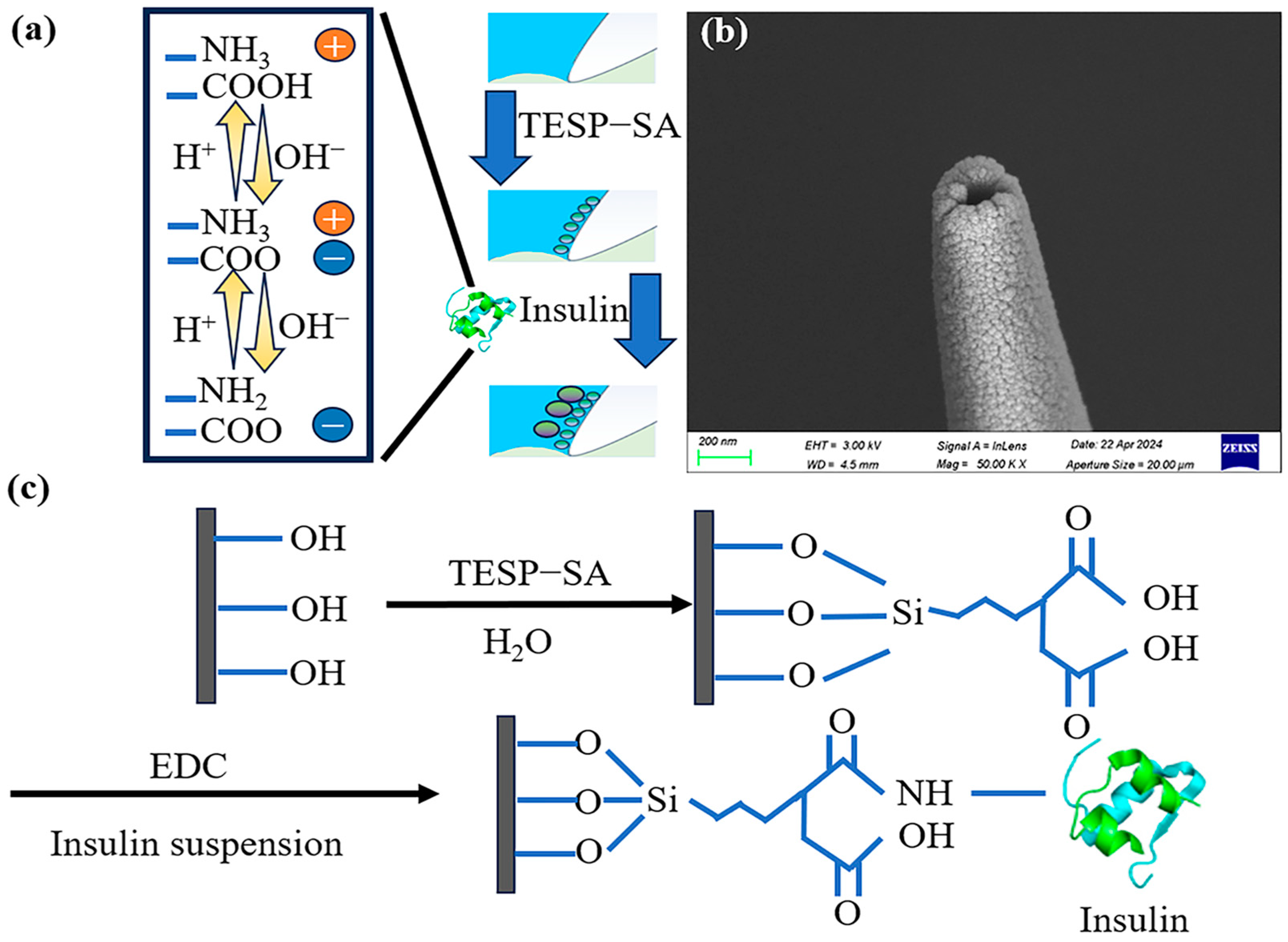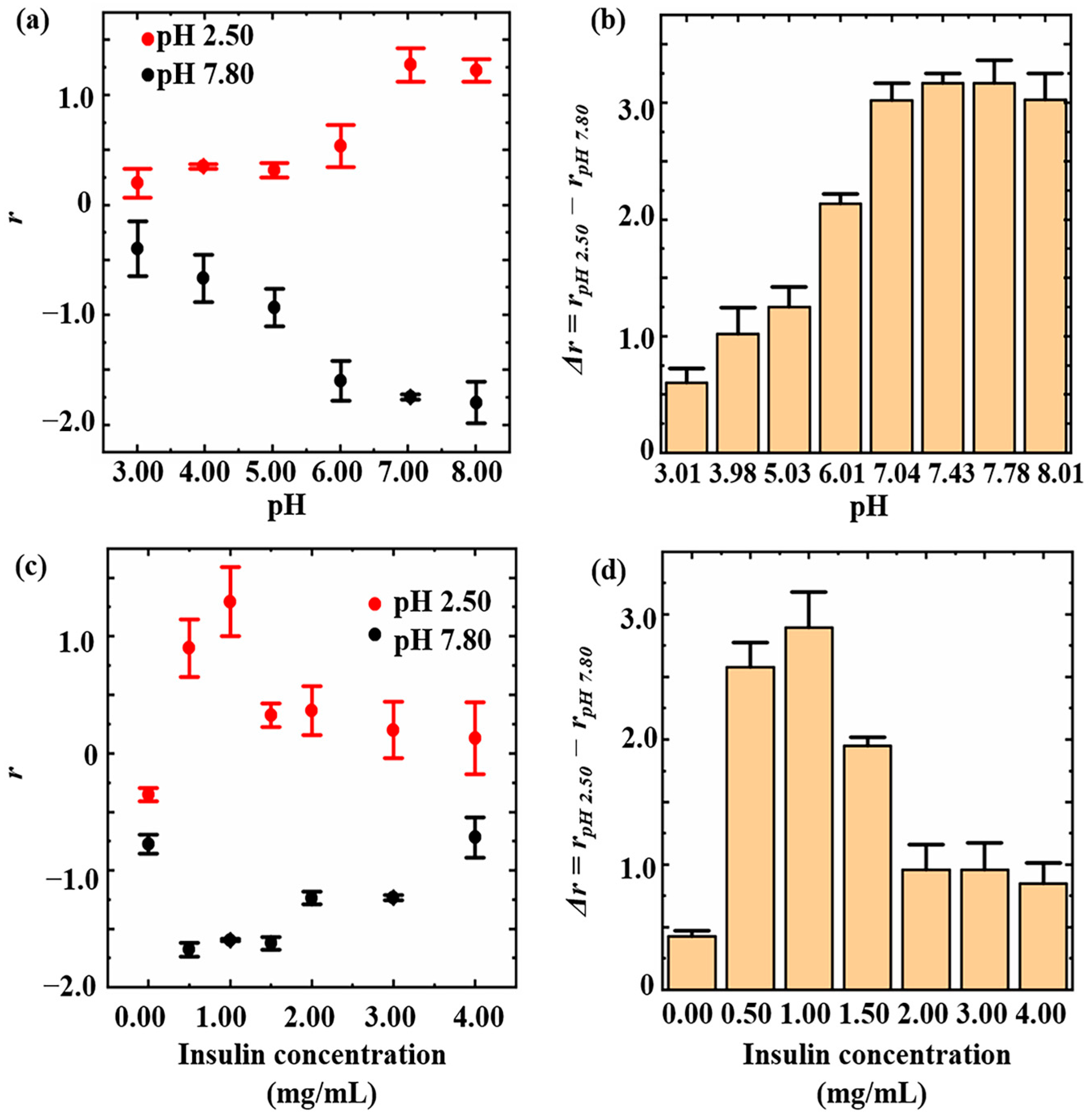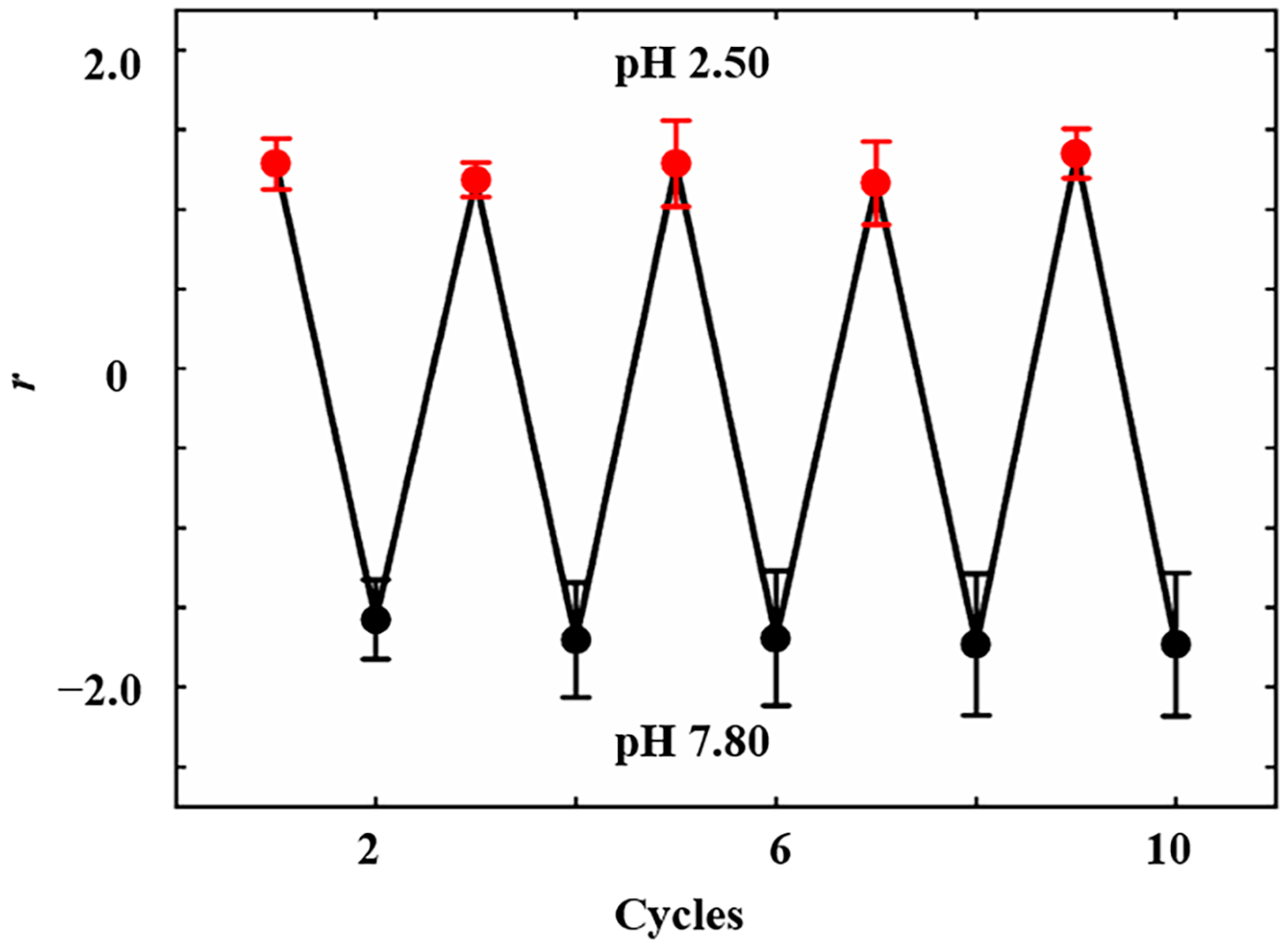An Insulin-Modified pH-Responsive Nanopipette Based on Ion Current Rectification
Abstract
:1. Introduction
2. Materials and Methods
2.1. Materials and Apparatus
2.2. Preparation and Modification of Nanopipettes
2.3. Electrochemical Characterization
3. Results
3.1. Optimization of Insulin Introduction Conditions
3.2. Monitoring of Modification Process
3.3. pH Response Behavior
4. Discussion and Conclusions
Supplementary Materials
Author Contributions
Funding
Institutional Review Board Statement
Informed Consent Statement
Data Availability Statement
Acknowledgments
Conflicts of Interest
References
- Pouysségur, J.; Franchi, A.; L’Allemain, G.; Paris, S. Cytoplasmic pH, a key determinant of growth factorinduced DNA synthesis in quiescent fibroblasts. FEBS Lett. 1985, 190, 115–119. [Google Scholar] [CrossRef]
- Wen, Y.; Jing, N.; Huo, F.; Yin, C. Recent progress of organic small molecule-based fluorescent probes for intracellular pH sensing. Analyst 2021, 146, 7450–7463. [Google Scholar] [CrossRef] [PubMed]
- Gottlieb, R.A.; Nordberg, J.; Skowronski, E.; Babior, B.M. Apoptosis induced in Jurkat cells by several agents is preceded by intracellular acidification. Proc. Natl. Acad. Sci. USA 1996, 93, 654–658. [Google Scholar] [CrossRef] [PubMed]
- Paroutis, P.; Touret, N.; Grinstein, S. The pH of the secretory pathway: Measurement, determinants, and regulation. Physiology 2004, 19, 207–215. [Google Scholar] [CrossRef] [PubMed]
- Weisz, O.A. Organelle acidification and disease. Traffic 2003, 4, 57–64. [Google Scholar] [CrossRef]
- Casey, J.R.; Grinstein, S.; Orlowski, J. Sensors and regulators of intracellular pH. Nat. Rev. Mol. Cell Biol. 2010, 11, 50–61. [Google Scholar] [CrossRef] [PubMed]
- Swietach, P.; Vaughan-Jones, R.D.; Harris, A.L.; Hulikova, A. The chemistry, physiology and pathology of pH in cancer. Philos. Trans. R. Soc. Lond. B Biol. Sci. 2014, 369, 20130099. [Google Scholar] [CrossRef] [PubMed]
- Hou, J.T.; Ren, W.X.; Li, K.; Seo, J.; Sharma, A.; Yu, X.Q.; Kim, J.S. Fluorescent bioimaging of pH: From design to applications. Chem. Soc. Rev. 2017, 46, 2076–2090. [Google Scholar] [CrossRef]
- Hunjan, S.; Mason, R.P.; Mehta, V.D.; Kulkarni, P.V.; Aravind, S.; Arora, V.; Antich, P.P. Simultaneous intracellular and extracellular pH measurement in the heart by 19F NMR of 6-fluoropyridoxol. Magn. Reson. Med. 1998, 39, 551–556. [Google Scholar] [CrossRef]
- Schroeder, M.A.; Swietach, P.; Atherton, H.J.; Gallagher, F.A.; Lee, P.; Radda, G.K.; Clarke, K.; Tyler, D.J. Measuring intracellular pH in the heart using hyperpolarized carbon dioxide and bicarbonate: A 13C and 31P magnetic resonance spectroscopy study. Cardiovasc. Res. 2010, 86, 82–91. [Google Scholar] [CrossRef]
- Wang, B.; Lu, S. The light of carbon dots: From mechanism to applications. Matter 2022, 5, 110–149. [Google Scholar] [CrossRef]
- Fang, L.; Pan, X.-T.; Liu, K.; Jiang, D.; Ye, D.; Ji, L.-N.; Wang, K.; Xia, X.-H. Surface-roughened SERS-active single silver nanowire for simultaneous detection of intracellular and extracellular pHs. ACS Appl. Mater. Interfaces 2023, 15, 20677–20685. [Google Scholar] [CrossRef]
- Perez-Mitta, G.; Albesa, A.G.; Trautmann, C.; Toimil-Molares, M.E.; Azzaroni, O. Bioinspired integrated nanosystems based on solid-state nanopores: “Iontronic” transduction of biological, chemical and physical stimuli. Chem. Sci. 2017, 8, 890–913. [Google Scholar] [CrossRef]
- Bulbul, G.; Chaves, G.; Olivier, J.; Ozel, R.E.; Pourmand, N. Nanopipettes as Monitoring Probes for the Single Living Cell: State of the Art and Future Directions in Molecular Biology. Cells 2018, 7, 55. [Google Scholar] [CrossRef]
- McCormick, H.K.; Dick, J.E. Nanoelectrochemical quantification of single-cell metabolism. Anal. Bioanal. Chem. 2021, 413, 17–24. [Google Scholar] [CrossRef] [PubMed]
- Hatami, A.; Zhang, X.; Oomen, P.E.; Ewing, A.G. Nanoscale Electrochemical Sensors for Intracellular Measurements at the Single Cell. In Handbook of Nanobioelectrochemistry: Application in Devices and Biomolecular Sensing; Springer Nature: Singapore, 2023; pp. 131–152. [Google Scholar]
- Ellis, D.; Thomas, R.C. Microelectrode measurement of the intracellular pH of mammalian heart cells. Nature 1976, 262, 224–225. [Google Scholar] [CrossRef]
- Pan, Y.; Zhang, K.; Wei, H.; Xiong, T.; Liu, Y.; Mao, L.; Yu, P. Double-Barreled Micropipette Enables Neuron-Compatible In Vivo Analysis. Anal. Chem. 2022, 94, 15671–15677. [Google Scholar] [CrossRef] [PubMed]
- Zhang, K.; Wei, H.; Xiong, T.; Jiang, Y.; Ma, W.; Wu, F.; Xu, P.; Mao, L. Micrometer-scale transient ion transport for real-time pH assay in living rat brains. Chem. Sci. 2021, 12, 7369–7376. [Google Scholar] [CrossRef] [PubMed]
- Lv, J.; Wang, X.Y.; Zhang, S.Y.; Zhou, X.Y.; Li, D.W.; Qian, R.C. Applications of nanopipettes in electrochemical analysis. Appl. Res. 2022, 1, e202100016. [Google Scholar] [CrossRef]
- Stuber, A.; Cavaccini, A.; Manole, A.; Burdina, A.; Massoud, Y.; Patriarchi, T.; Karayannis, T.; Nakatsuka, N. Interfacing Aptamer-Modified Nanopipettes with Neuronal Media and Ex Vivo Brain Tissue. ACS Meas. Sci. Au 2024, 4, 92–103. [Google Scholar] [CrossRef]
- Demirtas, M. Enhancing the sensitivity of nanopipette biosensors for protein analysis. Brain Behav. 2024, 14, e3405. [Google Scholar] [CrossRef]
- Chang, M.; Morgan, G.; Bedier, F.; Chieng, A.; Gomez, P.; Raminani, S.; Wang, Y. Review—Recent Advances in Nanosensors Built with Pre-Pulled Glass Nanopipettes and Their Applications in Chemical and Biological Sensing. J. Electrochem. Soc. 2020, 167, 037533. [Google Scholar] [CrossRef] [PubMed]
- Farrell, E.B.; McNeill, F.; Weiss, A.; Duleba, D.; Guiry, P.J.; Johnson, R.P. The Detection of Trace Metal Contaminants in Organic Products Using Ion Current Rectifying Quartz Nanopipettes. Anal. Chem. 2024, 96, 6055–6064. [Google Scholar] [CrossRef] [PubMed]
- Wang, Y.; Wang, D.; Mirkin, M.V. Resistive-pulse and rectification sensing with glass and carbon nanopipettes. Proc. Math. Phys. Eng. Sci. 2017, 473, 20160931. [Google Scholar] [CrossRef] [PubMed]
- Shao, Y.; He, P.; Yu, Z.; Liang, X.; Shao, Y. Modulation of ionic current behaviors based on a dual-channel micro/nano-pipette with ternary-form-charged model. J. Electroanal. Chem. 2022, 908, 116089. [Google Scholar] [CrossRef]
- Kececi, K.; Dinler, A.; Kaya, D. Review—Nanopipette Applications as Sensors, Electrodes, and Probes: A Study on Recent Developments. J. Electrochem. Soc. 2022, 169, 027502. [Google Scholar] [CrossRef]
- Wei, C.; Bard, A.J.; Feldberg, S.W. Current Rectification at Quartz Nanopipet Electrodes. Anal. Chem. 1997, 69, 4627–4633. [Google Scholar] [CrossRef]
- Jiang, Z.Y.; Liu, H.L.; Ahmed, S.A.; Hanif, S.; Ren, S.B.; Xu, J.J.; Chen, H.Y.; Xia, X.H.; Wang, K. Insight into Ion Transfer through the Sub-Nanometer Channels in Zeolitic Imidazolate Frameworks. Angew. Chem. Int. Ed. Engl. 2017, 56, 4767–4771. [Google Scholar] [CrossRef] [PubMed]
- Liu, G.-C.; Song, L.-B.; Gao, M.-J.; Wang, X.-H.; Li, C.-Q.; Liu, B.; Zhao, Y.-D.; Chen, W. Ion Current Rectification in High-Salt Environment from Mesoporous TiO2 Microplug in Situ Grown at the Tip of a Micropipette Induced by Space-Confined Evaporation. Anal. Chem. 2019, 91, 15377–15381. [Google Scholar] [CrossRef]
- Liu, G.-C.; Gao, M.-J.; Chen, W.; Hu, X.-Y.; Song, L.-B.; Liu, B.; Zhao, Y.-D. pH-modulated ion-current rectification in a cysteine-functionalized glass nanopipette. Electrochem. Commun. 2018, 97, 6–10. [Google Scholar] [CrossRef]
- Ozel, R.E.; Lohith, A.; Mak, W.H.; Pourmand, N. Single-cell intracellular nano-pH probes. RSC Adv. 2015, 5, 52436–52443. [Google Scholar] [CrossRef] [PubMed]
- Xiao, K.; Wen, L.; Jiang, L. Biomimetic Solid-State Nanochannels: From Fundamental Research to Practical Applications. Small 2016, 12, 2810–2831. [Google Scholar] [CrossRef] [PubMed]
- Liu, G.-C.; Chen, W.; Gao, M.-J.; Song, L.-B.; Hu, X.-Y.; Zhao, Y.-D. Ion-current-rectification-based customizable pH response in glass nanopipettes via silanization. Electrochem. Commun. 2018, 93, 95–99. [Google Scholar] [CrossRef]
- Liu, G.-C.; Song, L.-B.; Wang, X.-H.; Li, C.-Q.; Liu, B.; Zhao, Y.-D.; Chen, W. Ion current rectification in combination with ion current saturation. Anal. Chim. Acta 2020, 1117, 35–40. [Google Scholar] [CrossRef] [PubMed]
- Duleba, D.; Johnson, R.P. Proton enrichment and surface charge dynamics in pH-responsive nanopipettes. Electrochim. Acta 2024, 479, 143838. [Google Scholar] [CrossRef]
- Farías, R.N.; López Viñals, A.E.; Posse, E.; Morero, R.D. Relationship between isoelectric point of native and chemically modified insulin and liposomal fusion. Biochem. J. 1989, 264, 285–287. [Google Scholar] [CrossRef] [PubMed]
- Posner, B.I. Insulin Signalling: The Inside Story. Can. J. Diabetes 2017, 41, 108–113. [Google Scholar] [CrossRef] [PubMed]
- Østergaard, M.; Mishra, N.K.; Jensen, K.J. The ABC of Insulin: The Organic Chemistry of a Small Protein. Chemistry 2020, 26, 8341–8357. [Google Scholar] [CrossRef] [PubMed]
- Sehgal, D.; Vijay, I.K. A method for the high efficiency of water-soluble carbodiimide-mediated amidation. Anal. Biochem. 1994, 218, 87–91. [Google Scholar] [CrossRef]
- Li, Q.; Zhang, Y.; Wu, Z.; Huang, J.; Yue, N.; Huang, L.; Zhang, X. Tyrosine-EDC Conjugation, an Undesirable Side Effect of the EDC-Catalyzed Carboxyl Labeling Approach. Anal. Chem. 2021, 93, 697–703. [Google Scholar] [CrossRef]
- Saluja, A.; Kalonia, D.S. Nature and consequences of protein-protein interactions in high protein concentration solutions. Int. J. Pharm. 2008, 358, 1–15. [Google Scholar] [CrossRef] [PubMed]
- Wang, X.; Wang, Y.; Pan, W.; Wang, J.; Sun, X. Carbon-dot-based probe designed to detect intracellular pH in fungal cells for building its relationship with intracellular polysaccharide. ACS Sustain. Chem. Eng. 2021, 9, 3718–3726. [Google Scholar] [CrossRef]
- Liu, Q.; Niu, X.; Zhang, Y.; Zhao, Y.; Xie, K.; Yang, B.; He, Q.; Lv, S.; Li, L. Carbon dots for lysosome targeting and imaging of lysosomal pH and Cys/Hcy in living cells. Nanoscale 2020, 12, 13010–13016. [Google Scholar] [CrossRef] [PubMed]
- Beylkin, G.; Burridge, R. Linearized inverse scattering problems in acoustics and elasticity. Wave Motion 1990, 12, 15–52. [Google Scholar] [CrossRef]
- Valagiannopoulos, C.A. A Novel Methodology for Estimating the Permittivity of a Specimen Rod at Low Radio Frequencies. J. Electromagn. Waves Appl. 2010, 24, 631–640. [Google Scholar] [CrossRef]
- Cook, J.L. A note on inverse scattering calculations of energy-independent potentials. Aust. J. Phys. 1973, 26, 561. [Google Scholar] [CrossRef]






Disclaimer/Publisher’s Note: The statements, opinions and data contained in all publications are solely those of the individual author(s) and contributor(s) and not of MDPI and/or the editor(s). MDPI and/or the editor(s) disclaim responsibility for any injury to people or property resulting from any ideas, methods, instructions or products referred to in the content. |
© 2024 by the authors. Licensee MDPI, Basel, Switzerland. This article is an open access article distributed under the terms and conditions of the Creative Commons Attribution (CC BY) license (https://creativecommons.org/licenses/by/4.0/).
Share and Cite
Wang, X.-F.; Duan, Y.-F.; Zhu, Y.-Q.; Liu, Z.-J.; Wu, Y.-C.; Liu, T.-H.; Zhang, L.; Wei, J.-F.; Liu, G.-C. An Insulin-Modified pH-Responsive Nanopipette Based on Ion Current Rectification. Sensors 2024, 24, 4264. https://doi.org/10.3390/s24134264
Wang X-F, Duan Y-F, Zhu Y-Q, Liu Z-J, Wu Y-C, Liu T-H, Zhang L, Wei J-F, Liu G-C. An Insulin-Modified pH-Responsive Nanopipette Based on Ion Current Rectification. Sensors. 2024; 24(13):4264. https://doi.org/10.3390/s24134264
Chicago/Turabian StyleWang, Xu-Fan, Yi-Fan Duan, Yue-Qian Zhu, Zi-Jing Liu, Yu-Chen Wu, Tian-Hao Liu, Ling Zhang, Jian-Feng Wei, and Guo-Chang Liu. 2024. "An Insulin-Modified pH-Responsive Nanopipette Based on Ion Current Rectification" Sensors 24, no. 13: 4264. https://doi.org/10.3390/s24134264
APA StyleWang, X.-F., Duan, Y.-F., Zhu, Y.-Q., Liu, Z.-J., Wu, Y.-C., Liu, T.-H., Zhang, L., Wei, J.-F., & Liu, G.-C. (2024). An Insulin-Modified pH-Responsive Nanopipette Based on Ion Current Rectification. Sensors, 24(13), 4264. https://doi.org/10.3390/s24134264






